provided by:
Priscilla Sokolowski
Eugene, OR
Photos from personal trips AND trips with
“Birds of Oregon and General Science” (BOGS)
Priscilla’s
Bird photography

provided by:
Priscilla Sokolowski
Eugene, OR
Photos from personal trips AND trips with
“Birds of Oregon and General Science” (BOGS)
Priscilla’s
Bird photography




Wood Ducks
Stages of Development
☰ Indeterminate ☰
☰ Gray Zone ☰
☰ 1st Signs ☰
☰ Further Along ☰
☰ Later Stages ☰
Adult Wood Ducks
Adult Female Wood Ducks have several good identifying field marks.
The large teardrop-shaped white patch surrounding the eye is the most obvious field mark.
Except perhaps in late Spring and until August, females breasts have a deep rich brown base color.


Another field mark of the adult female Wood Duck is the white border around the base of her bill.
This is visible from about August 1 and continues well through the breeding season.
I am not sure if the females lose this white border around the bill during the Summer months - but they might.


The adult male Wood Duck is spectacularly colorful. For the purposes of identifying young birds as males, note in particular, the orange eye and the orange bill and the white "bridle" markings on the side of the face, coming up from the neck. Faint traces of these white markings are the very first sure sign that a young bird will develop into an adult male.


Adult female Wood Ducks appear to go through two stages of coloring. Not feathers so much as the bill. From courtship in late August and September until around May give or take a month, they have a clear white border around the base of their bill. During the several months they are raising young, this white border seems to disappear, if not in all of them, at least in many.
The following photo was taken late in Summer; on August 31 (2017). Now, I've seen adult wood ducks being territorial, displaying, and pairing up one September (Sept 12, yr: ? 2014?). Both males and females were already in full breeding plumage. By mid-September.
The only feature/field marks which are obvious to me in the adult female Wood Duck, are the richness of the brown breast feathers, and the white border around the base of her bill.
One of the birds below; the one on the left, is an adult female. The other one ... well she's a female, but look at the breast feathers; they are not as rich in color or even all that sharply defined. So I am thinking that the bird on the right is a first-Summer female, still molting into an adult plumage.


INDETERMINATE STAGE
After hatching, and for longer than a month, male and female Wood duck chicks cannot told apart.
Here is a group of Wood Duck chicks


Closer and side-view of faces of chicks


This photo, taken June 15, 2014, shows us that the adult female; the mother of these ducklings, does not have a very pronounced white border around the base of her bill at this time of year. Starting around late August or September as she goes into "alternate" or breeding plumage, that white border around the base of the bill returns and her colors generally get richer; ie, deeper brown especially on her breast.


Here's a very close look at the side of the face before any clear male or female indicators have started to show up. Especially obvious is the light-colored supercilium stripe above the eye. This is common to both sexes. It begins to fade sooner in male birds.


Go to top of page
First Signs
Eventually Wood Duck chicks begin to show changes in their facial coloring which indicate
their sex. This happens in young male birds a few weeks sooner than in female birds.
The first clear sign that a Wood Duck chick is developing into a male, is the white "bridle-like" markings coming up from the throat and up the side of the face. When fully adult these white markings are very pronounced and contribute to the dramatic coloring of the male.
In the following photos, the white markings make only a faint trace on the side of the face and the white supercilium stripe common to all the young chicks still remains but has begun to fade.




The next photo shows a bird resolving into a male. The supercilium stripe is all but gone. Instead, a split white eye-ring is present. This develops for only a short while before vanishing again. It vanishes at the same time as the eye develops the orange color it will eventually have. This bird already shows a trace of orange color in the eyes.

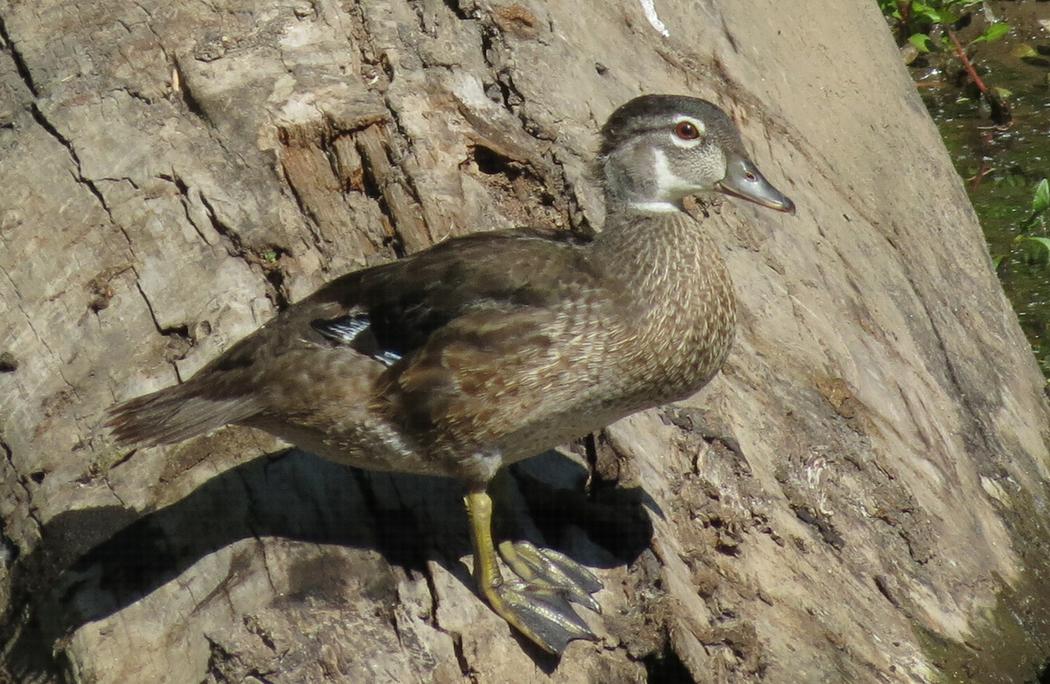
Young female Wood Ducks have fewer clear early indicators. The white eye-ring grows larger and more tear-drop shaped, extending further behind the eye. However, before this happens. young birds resolving into males have already shown several fairly clear indications of their sex.
This young female shows the white eye-ring beginning to develop. Photo taken August 1, 2013. Only the female birds develop this to such an extent, and in the adult female it is the most visible identifying field mark. Apparently young male birds which have already shown clear indications of their sex, go through a brief stage in which a white eye-ring develops, but instead of growing larger, it shrinks down to nothing in a few weeks or less.

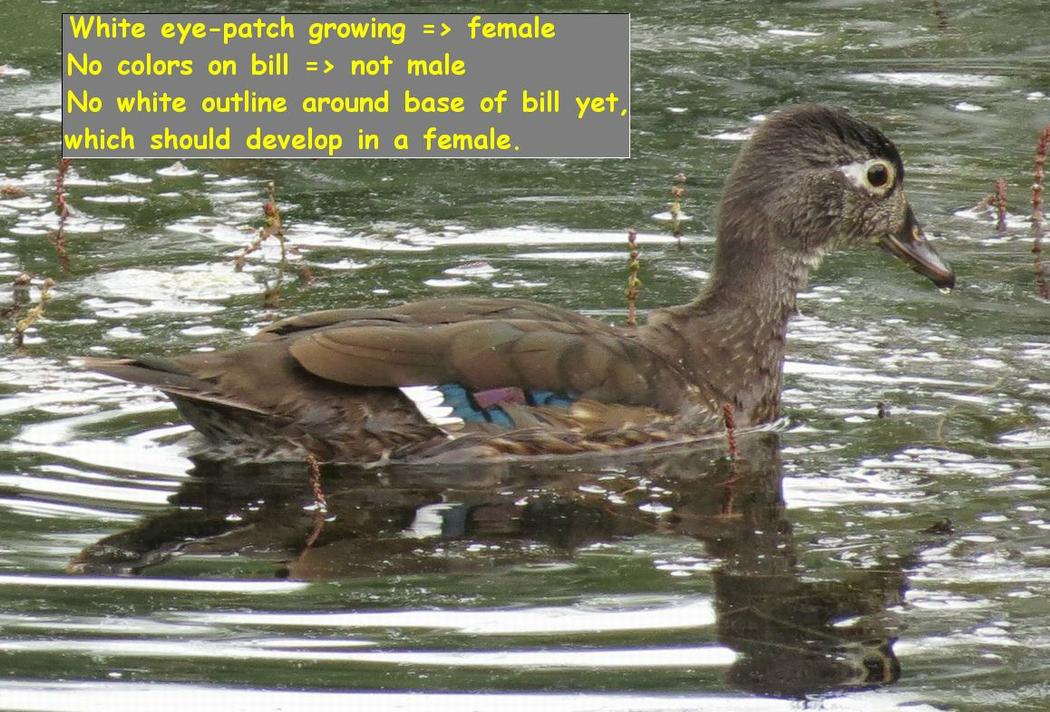
Here are both male and female birds each showing enough signs to indicate their sexes, even
though the male has only the clear white bridle-markings but no orange color in bill nor eye.
Photo taken August 1, 2013


Earlier "Gray Zone" stage
Now that we have looked at the first indicators of the sex of young Wood Ducks, let's go back to what
is seen in birds in which the sex is perhaps still indeterminate, but in which there are some barely visible traces of what is coming
Notice in this next bird, photographed September 1, 2013, there is a complete white eye-ring. Male birds at this same age develop a split eye-ring, for only a short time, more prominent (wider) below the eye than above the eye. Only female birds develop this complete eye-ring, which is wide both at top and bottom, and nearly symmetrical.
For the sake of completeness, notice there are no traces of orange in the eye or bill and little if any trace of the white "bridle" markings which a male bird at this age would be showing. While I would not say that this is definitely a female bird, I think it is very likely female.

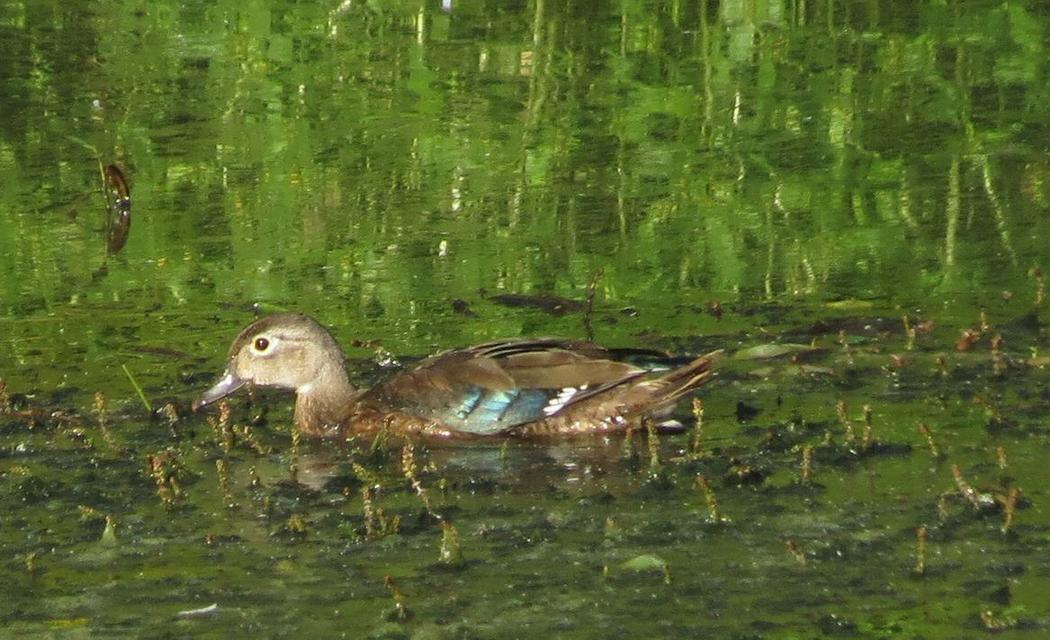
This next photo, taken September 7, 2013, is probably a male bird. I would not say it is definitely male, but it is very likely male. Notice there is only a white border below the eye in this bird, and below the chin has become very white. Those are both in contrast to the likely female bird we just discussed. In the bird below, there are little if any traces of the white bridle markings, and no traces of orange in the bill or eye which would clearly indicate a male bird, so it is in what I would call the "Gray Zone" between indeterminate birds and those showing clear "1st Signs" of their sex.


The following picture shows a male bird a little further along; showing not only more pronounced white "bridle" markings, but also the beginnings of orange in the bill and eye.


Later Stages
There is little question about the sex of young Wood Ducks once the white bridle markings are clear in the male
and the white tear drop shaped eye patch has grown large in the female. In the later stages, male birds develop
orange in the eye and their bill. In both male and female birds, a crest begins to grow from the crown of the head. In both
sexes, this has a deep green color to it, though this is irridescence rather than the color of the feathers.
an
This next photo shows a male bird with orange developing in its eye, and on its bill. Oddly, the white bridle markings hardly seem visible in this bird. That's pretty rare for a male bird with some orange coloration showing up.

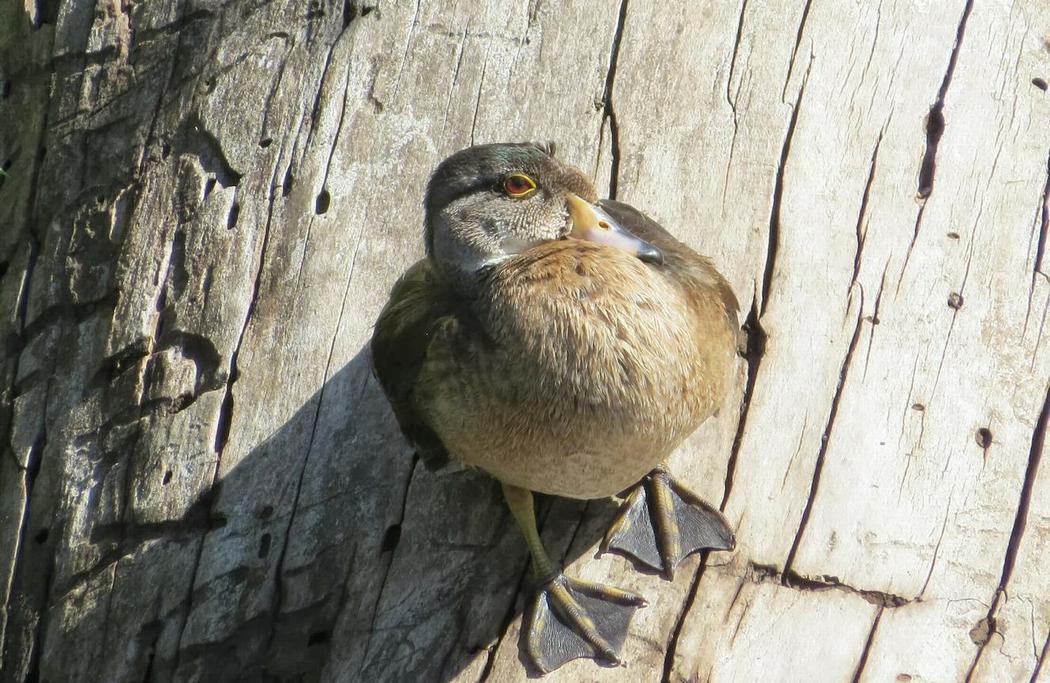
A very typical later-stage young male Wood Duck is shown in the next photo.


And a few more birds with all the clear signs of young male Wood Ducks.

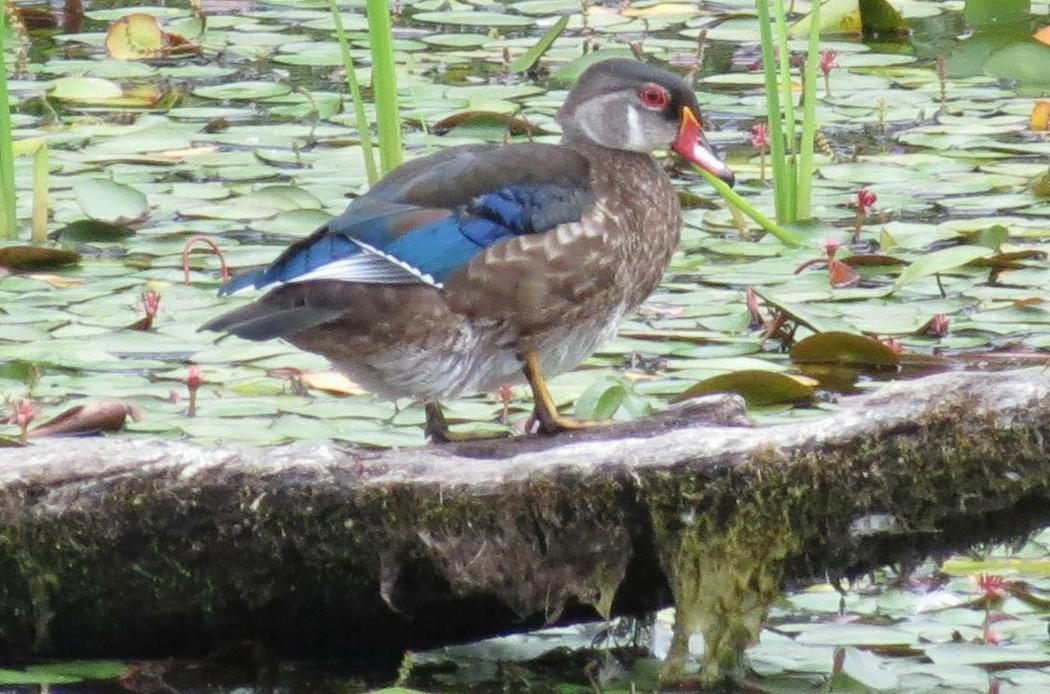


Females are more challenging because as young adults they do not show much in the way of field marks. This is further complicated by trying to separate young adults from adults in eclipse plumage. I'm not certain about the white around the base of the bill during the early Summer months in adult birds.
In the following photo there is little or no doubt that the bird on the far right is a young female. She's got a complete white eye-ring and no white bridle markings or orange in bill or eye which would be seen in a male bird. Of the two birds on the left, one has the white around the base of the bill and the other doesn't. This photo was taken on Sept 1, 2013. By that time many males and females are already in full "alternate" (breeding) plumage, though not all of them are. Perhaps the two females on the left are both adults, with one not yet fully in alternate plumage.

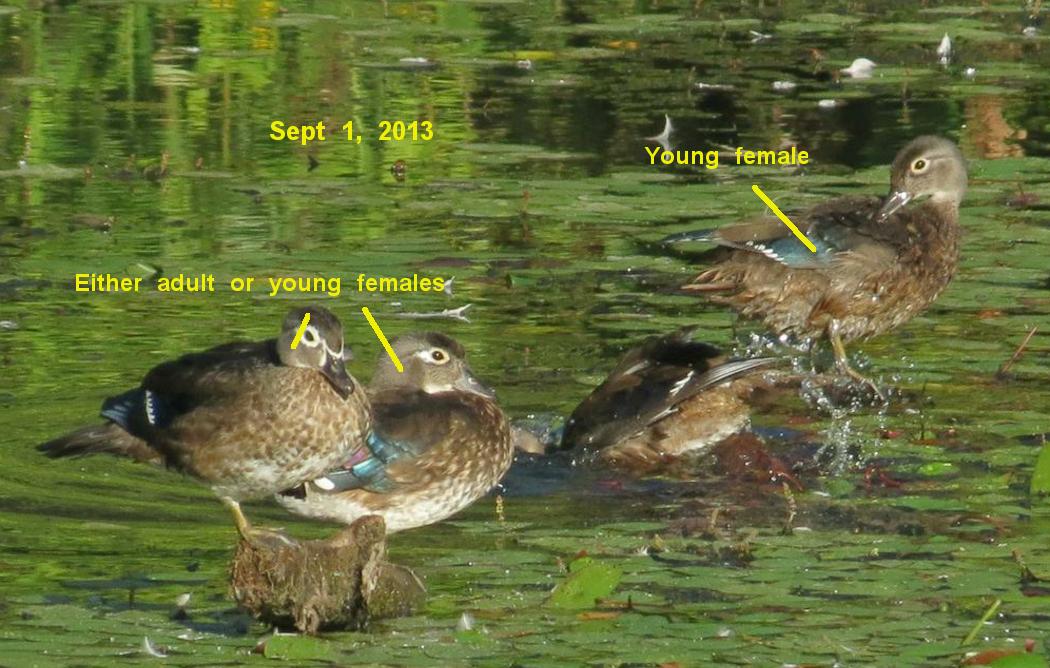
ECLIPSE PLUMAGE
Breeding plumage in adult birds is called "alternate" plumage. During the off-season,
they molt to what is called "Basic" plumage. After the breeding season, ducks loose and replace many or most
of their feathers, including flight feathers of male birds; (which is the basis for the expression "lame ducks" for male ducks at this time).
The more formal name for the appearance of ducks which are loosing they alternate (breeding) plumage, is Eclipse Plumage
While I do not have many photographs of Wood Ducks in eclipse plumage, the few I have are sufficient to establish that the seasonal timing of this varies from year to year and place to place. They are also sufficient to demonstrate the difference in appearance of adult male Wood Ducks in eclipse plumage compared to hatch-year male birds developing adult coloring for their first time.
The following group of photographs are being presented in chronological order from April to September; including photos from three different years. In both April and in September adult Wood Duck males can be found in full alternate (breeding) plumage.
Go to top of page
Pipit run with Joel Geier, Feb 28, 2018
One of the pre-eminent birders who posts regularly if not daily, on OBOL (Oregon Birders Online - an email listserve), Joel Geier, took five of us BOGS members on a tour of some of the areas where American Pipits, Horned Larks, Grasshopper Sparrows and Vesper Sparrows can be found at various times of the year.
Near the Rice Ponds South of Lake Creek Rd & Gap Rd, we saw this dark-morph Red-tailed Hawk. I'd not seen one of these before.




The habitat along Belts Road, from where it intersects Gap Rad, to where Tub Run Road rejoins Belts from the East, is an important remnant of Willamette Valley native grasslands.
Grasshopper Sparrows and Vesper Sparrows both depend on native grassland habitat like this. Only a few breeding pairs of these species remain in this area.




This large parcel of land on the east side of Gap Rd's intersection with Belts Rd, is owned by a famous actor. There are hopes that the owner can be persuaded to agree to some kind of habitat preservation and/or restoration.


Joel Geier showed us the specific species of native grass which when going to see, shoots up taller than the belly of an adult horse. He said the Calapooia Indians, who lived in this area were sometimes called "People of the tall grass".


Go to top of page
Delta Ponds Birds and Mammals, February 23-27, 2018
Male Gadwall, followed by male/female Gadwall pair; Delta Ponds Goodpasture Rd, Feb 27, 2018




Go to top of page
Ring-necked duck, female; Delta Ponds Goodpasture Rd, Feb 27, 2018




Ring-necked duck, male; Delta Ponds Goodpasture Rd, Feb 27, 2018


There were some very fresh Beaver gnawings along the trail which were NOT there on the 23rd.
Photo taken at Delta Ponds along Goodpasture Island Rd, Feb 27, 2018








Go to top of page
Northern Shoveler, shoveling just under the surface of the water.
Taken Feb 27, 2018


Anna's Hummingbird




Tundra Swans on Meadowview Rd.




We saw these further north in Linn county. At the time we didn't know what they were, but now that I have looked at photos online, I think these are Dunlin. We have been seeing flocks of Dunlin the last few weeks in various areas of Lane and Linn counties.


We ended our birding that day as sunset was approaching, at the Tangent Eagle Roost. There were two other car-loads of birders there, one of which was from Eugene. Dave Stone was in that group. He sent me the following photo he took of the Bald Eagles in the roost trees that evening.
Bald Eagles roost here during the Winter months, essentially December-March; during lambing season. Counts of Eagles in the roosting trees get as high as about 120 on some years. This year I don't think I saw a count higher than 101.


Native Muskrat at Delta Ponds. Feb. 23. I rarely see these, but they are around. They're about half the size of an adult Nutria, and their tail is nearly half as long as their body, while Nutria tails are shorter in proportion to their bodies. In these photos one can see how narrow and pointed the Muskrat's snout is. Nutria have broader, flatter faces and their ears are not as far behind the eyes. You can see how far the Muskrat's ears are behind the eyes.








This is where the Muskrat was feeding. A year or two ago I was told there was a River Otter lodge at this location, though I have never verified that myself. There was also a Mink on the ridge on the other side of the water within a minute of seeing the Muskrat swim away. I couldn't get a photo of the Mink before it ran into the brush.


Go to top of page
Questions about BOGS? EMAIL: priscilla@blog.priscillanhk.com
Generally if you want to know what is happening next at BOGS, or want to see the latest photos/reports,
you can find these on the HOME page:
http://priscillanhk.com/index.html
Enjoy!
Priscilla